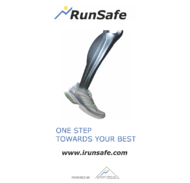Cadence, foot strikes and stride length - step by step
Posted by Anthony Luke MD, MPH on April 22, 2022

The Starting Line:
How do cadence and stride length relate?
For beginner runners running with a more frequent shorter stride is often preferred rather then a long stride. A popular concept to think about now is considering your cadence which is how often your foot hits the ground in one minute. Ideally your stride should be close to 170-180 foot strikes per minute so each foot lands 85-90 times each minute on each side. Careful review of several studies showed that an increased stride rate and reduced stride length appeared to reduce the effect of several key biomechanical factors associated with running injuries.
Presently there is much interest on how people land as they stride. Traditionally in North America most people have been heel striking which means landing with the heel first then toeing off like how people walk. The concern has been that he'll striking me cause more impact to lower extremities. This was popularized by Dr. Dan Lieberman's work, an anthropologist from Harvard who publish this research in Nature magazine as well as the popular book "Born to Run". There maybe benefits to striking on the midfoot or forefoot for some individuals. These issues become more of an issue for runners who are running regularly and for long distances. Again, listen to your body and observing for injuries are important for the beginner runner to make sure your take me is best suited for the runner. The scientific community is contacting further studies now to learn more about this risk factor.
Finish line:
Pay attention to your cadence, foot strike patterns and stride length. They are all related and will ultimately determine your speed and impact to the lower legs.
References:
1. Schubert AG, Kempf J, Heiderscheit BC. Influence of stride frequency and length on running mechanics: a systematic review. Sports Health. 2014 May;6(3):210-7. https://pubmed.ncbi.nlm.nih.gov/24790690/
Photo Credit: Sportzpeak Inc.
*Note: This general information is not intended to be a substitute for medical treatment or advice. Always consult a professional before making changes to your health and wellness practices.
Feedback or suggestions for future topics? Let us know!

